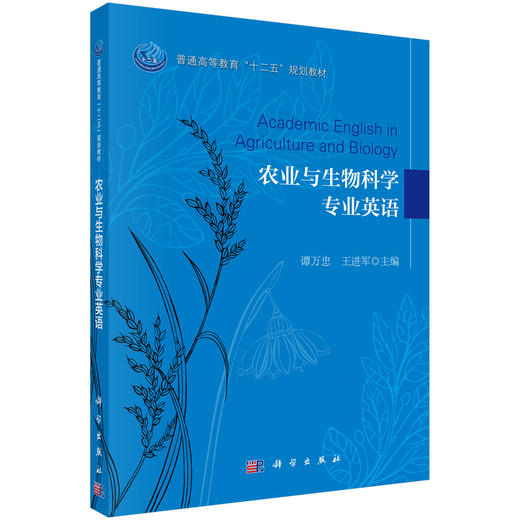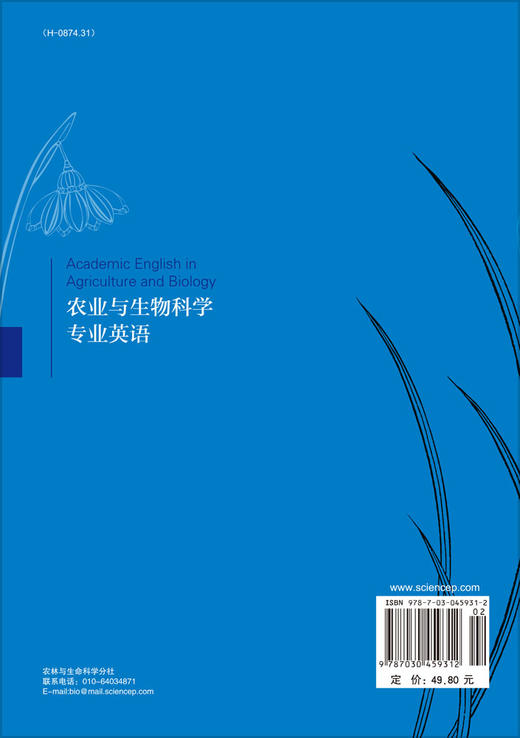商品详情
书名:农业与生物科学专业英语
定价:59.8
ISBN:9787030459312
作者:谭万忠,王进军
版次:1
出版时间:2023-07
内容提要:
迄今国内绝大多数高校及大多数专业都开设了专业英语课程,但已有的相关教材和课程教学内容几乎均仅限于专业文献的选读,这样既限制学生学习课程的兴趣也影响教学质量。本书是作者对学习和教授专业英语课程的经验与教学成果的总结,其内容和编排系统都较新颖。全书内容分为9章,第1章概述专业英语的相关概念、课程内涵及学习策略;第2章讲述英文词汇学与词汇快速扩充方法;在第3章介绍提高文献阅读效率的技巧之后,第4章选编8篇农学与生物学文献供学生进行阅读实践;第5~7章讨论英语的写作基本理论知识,包括文章的组织结构与衔接、常见写作错误与校正及重要的语言程式;第8~9章分别讨论事务信函和科研论文的写作。每章都附有中文提要
目录:
Contents
前言
Chapter 1 An Introduction to Academic English 1
1.1 Concept of academic English 1
1.2 Academic English course 2
1.3 The academic English course book 2
1.4 Organizing your study 3
1.5 Strategies for English learning 6
Chapter 2 Learning New Words and Extending Your Vocabulary 9
2.1 General strategies and skills for learning new words 9
2.2 English word formation 16
2.2.1 Conversion of words 16
2.2.2 Word compounding 18
2.2.3 Abbreviation 21
2.2.4 Affixation 24
2.3 Word roots 27
2.3.1 Some common roots 27
2.3.2 Exploring the basics of roots 28
2.4 Word element 30
2.4.1 Origin of word elements 30
2.4.2 Some words and their element forms 31
Chapter 3 Techniques for Improving Efficiency of
Reading English Literatures 33
3.1 Reading with a purpose 33
3.2 Using the title 35
3.3 Surveying a book 37
3.4 Surveying a text using first few lines of paragraphs 40
3.5 Surveying a text using the first and the last paragraphs 42
3.6 Scanning 44
3.7 Knowing meaning of words or phrases in context 45
3.8 Multiple reading skills by knowing the text organization 45
Chapter 4 Selected Readings in Biology and Agriculture 50
4.1 Microorganism 50
4.1.1 History 51
4.1.2 Classification and structure 52
4.1.3 Habitats and ecology 55
4.1.4 Importance 56
4.2 Agriculture 59
4.2.1 Etymology and terminology 60
4.2.2 History 60
4.2.3 Workforce 68
4.2.4 Safety 68
4.2.5 Agricultural production systems 69
4.2.6 Production practices 71
4.2.7 Crop alteration and biotechnology 72
4.2.8 Environmental impact 73
4.2.9 Agricultural economics 76
4.2.10 Agriculture policy 77
4.3 Systematics,taxonomy and classification 78
4.3.1 The importance of biological classification 79
4.3.2 Taxonomic hierarchies 79
4.3.3 The goals of classification systems 81
4.3.4 Phenetic systematics 82
4.3.5 Cladistic systematics 83
4.3.6 Constructing phylogenies 84
4.3.7 Taxonomic keys 89
4.3.8 Summary 89
4.4 Weed management in organic crop production 90
4.4.1 Prevention 90
4.4.2 Sanitation 91
4.4.3 Cultural control 92
4.4.4 Crop competition 93
4.4.5 Mechanical control by tillage 96
4.4.6 Harvest management 99
4.4.7 Other control methods 99
4.4.8 Allelopathy 100
4.4.9 Biological weed control 101
4.4.10 Conclusion 101
4.5 Genetically modified crops 102
4.5.1 Gene transfer in nature and traditional agriculture 102
4.5.2 History 102
4.5.3 Methods 103
4.5.4 Types of genetic engineering 104
4.5.5 Business of GM crops 105
4.5.6 Uses,actual and proposed 106
4.5.7 Extent of worldwide use of GM crops 108
4.5.8 Examples of genetically modified crops 109
4.5.9 Effects on farming practices 111
4.5.10 Regulation 112
4.5.11 Controversy 112
4.6 Archaea:the life’s extremists 112
4.6.1 Archaea fossil record 114
4.6.2 Archaea ecology 115
4.6.3 Archaea systematics 116
4.6.4 Archaea morphology 118
4.7 Plant genomics-sowing the seeds of success 122
4.7.1 Crop genomics:growing potential 122
4.7.2 Model behavior:lessons from Arabidopsis and Brachypodium 123
4.7.3 Sensing change:responses to the environment 124
4.7.4 The tree of life 125
4.7.5 Concluding remarks 125
4.8 Lichens:an alliance between kingdoms 126
4.8.1 Fossil record of lichens 126
4.8.2 Life history and ecology 127
4.8.3 Systematics of lichens 129
4.8.4 More on morphology of lichens 129
Chapter 5 Awareness and Correction of Errors in Writing 132
5.1 Some common causes of error 132
5.2 Errors and corrections in standard usage 133
5.2.1 Cases of nouns and pronouns 133
5.2.2 Agreement of verb with subject 134
5.2.3 Agreement of pronoun with antecedent 135
5.2.4 Agreement of denominative adjective with its object 136
5.3 Unity and coherence in the sentence 136
5.3.1 Unity of thought 136
5.3.2 Unity of structure 137
5.3.3 Coherence 138
5.4 Errors and correction in spelling 141
5.4.1 Some effective ways of reducing misspelling 141
5.4.2 Some principles of spelling 142
5.5 Correct use of vocabulary and grammar 145
5.6 Writing styles 147
5.7 Writing tentativeness 149
Chapter 6 Structural Organization and Cohesion of General Texts 151
6.1 AND type connectives 152
6.2 OR type connectives 154
6.3 BUT type connectives 155
Chapter 7 Language Function 157
7.1 Language function one:description 157
7.1.1 Describing the size of things 157
7.1.2 Describing shape and orientation 159
7.1.3 Describing climate 160
7.1.4 Describing process 161
7.2 Language function two:definition 163
7.2.1 General definition 163
7.2.2 Reduced definition 163
7.2.3 Definition of academic subjects 164
7.3 Language function three:exemplification 164
7.4 Language function four:classification and analysis 165
7.4.1 Classification 165
7.4.2 Analysis 167
7.5 Language function five:comparison and contrast 168
7.5.1 Comparison 169
7.5.2 Contrast 169
7.5.3 Superlative 170
7.5.4 Comparative 170
7.6 Language function fix:cause and effect 171
7.7 Language function seven:generalization and qualification 174
7.8 Language function eight:interpretation of data 176
7.9 Language function nine:argumentation 178
7.10 Language function ten:drawing conclusions 179
Chapter 8 Writing Business Letters 182
8.1 The form of business letters 182
8.2 Parts of a business letter 184
8.2.1 Regular parts 184
8.2.2 Special parts of a letter 185
8.3 Parts of the envelope 187
8.3.1 Regular parts of an envelope 187
8.3.2 Special parts of an envelope 188
8.4 Some principles of writing contents of the business letter 188
8.5 Special types of business letters 189
8.5.1 Letter of enquiry 189
8.5.2 Order letter 190
8.5.3 Letter of applications and résumé 191
8.6 Concluding remarks 205
Chapter 9 Whiting a Research Paper 206
9.1 Title of a paper 206
9.1.1 The topic 206
9.1.2 The authors and their addresses 207
9.2 The abstract 208
9.2.1 Informative abstracts 208
9.2.2 Indicative abstracts 209
9.2.3 Structured abstracts 209
9.2.4 Key words 210
9.3 Introduction 210
9.4 Materials and methods 211
9.4.1 Materials 211
9.4.2 Methods 212
9.5 Results 213
9.6 Discussion 213
9.7 Conclusions 215
9.8 Acknowledgements 215
9.9 References 215
Appendix Ⅰ Groups of Affixes of English Words 217
Appendix Ⅱ Common Group of Irregular Verbs 222
Appendix Ⅲ List of Irregular Nouns 227
Appendix Ⅳ Some Common Latin Phrases in English Literatures 231
Appendix Ⅴ Some New or Unfamiliar Words and Phrases in this Book 234
Appendix Ⅵ Important References 239
定价:59.8
ISBN:9787030459312
作者:谭万忠,王进军
版次:1
出版时间:2023-07
内容提要:
迄今国内绝大多数高校及大多数专业都开设了专业英语课程,但已有的相关教材和课程教学内容几乎均仅限于专业文献的选读,这样既限制学生学习课程的兴趣也影响教学质量。本书是作者对学习和教授专业英语课程的经验与教学成果的总结,其内容和编排系统都较新颖。全书内容分为9章,第1章概述专业英语的相关概念、课程内涵及学习策略;第2章讲述英文词汇学与词汇快速扩充方法;在第3章介绍提高文献阅读效率的技巧之后,第4章选编8篇农学与生物学文献供学生进行阅读实践;第5~7章讨论英语的写作基本理论知识,包括文章的组织结构与衔接、常见写作错误与校正及重要的语言程式;第8~9章分别讨论事务信函和科研论文的写作。每章都附有中文提要
目录:
Contents
前言
Chapter 1 An Introduction to Academic English 1
1.1 Concept of academic English 1
1.2 Academic English course 2
1.3 The academic English course book 2
1.4 Organizing your study 3
1.5 Strategies for English learning 6
Chapter 2 Learning New Words and Extending Your Vocabulary 9
2.1 General strategies and skills for learning new words 9
2.2 English word formation 16
2.2.1 Conversion of words 16
2.2.2 Word compounding 18
2.2.3 Abbreviation 21
2.2.4 Affixation 24
2.3 Word roots 27
2.3.1 Some common roots 27
2.3.2 Exploring the basics of roots 28
2.4 Word element 30
2.4.1 Origin of word elements 30
2.4.2 Some words and their element forms 31
Chapter 3 Techniques for Improving Efficiency of
Reading English Literatures 33
3.1 Reading with a purpose 33
3.2 Using the title 35
3.3 Surveying a book 37
3.4 Surveying a text using first few lines of paragraphs 40
3.5 Surveying a text using the first and the last paragraphs 42
3.6 Scanning 44
3.7 Knowing meaning of words or phrases in context 45
3.8 Multiple reading skills by knowing the text organization 45
Chapter 4 Selected Readings in Biology and Agriculture 50
4.1 Microorganism 50
4.1.1 History 51
4.1.2 Classification and structure 52
4.1.3 Habitats and ecology 55
4.1.4 Importance 56
4.2 Agriculture 59
4.2.1 Etymology and terminology 60
4.2.2 History 60
4.2.3 Workforce 68
4.2.4 Safety 68
4.2.5 Agricultural production systems 69
4.2.6 Production practices 71
4.2.7 Crop alteration and biotechnology 72
4.2.8 Environmental impact 73
4.2.9 Agricultural economics 76
4.2.10 Agriculture policy 77
4.3 Systematics,taxonomy and classification 78
4.3.1 The importance of biological classification 79
4.3.2 Taxonomic hierarchies 79
4.3.3 The goals of classification systems 81
4.3.4 Phenetic systematics 82
4.3.5 Cladistic systematics 83
4.3.6 Constructing phylogenies 84
4.3.7 Taxonomic keys 89
4.3.8 Summary 89
4.4 Weed management in organic crop production 90
4.4.1 Prevention 90
4.4.2 Sanitation 91
4.4.3 Cultural control 92
4.4.4 Crop competition 93
4.4.5 Mechanical control by tillage 96
4.4.6 Harvest management 99
4.4.7 Other control methods 99
4.4.8 Allelopathy 100
4.4.9 Biological weed control 101
4.4.10 Conclusion 101
4.5 Genetically modified crops 102
4.5.1 Gene transfer in nature and traditional agriculture 102
4.5.2 History 102
4.5.3 Methods 103
4.5.4 Types of genetic engineering 104
4.5.5 Business of GM crops 105
4.5.6 Uses,actual and proposed 106
4.5.7 Extent of worldwide use of GM crops 108
4.5.8 Examples of genetically modified crops 109
4.5.9 Effects on farming practices 111
4.5.10 Regulation 112
4.5.11 Controversy 112
4.6 Archaea:the life’s extremists 112
4.6.1 Archaea fossil record 114
4.6.2 Archaea ecology 115
4.6.3 Archaea systematics 116
4.6.4 Archaea morphology 118
4.7 Plant genomics-sowing the seeds of success 122
4.7.1 Crop genomics:growing potential 122
4.7.2 Model behavior:lessons from Arabidopsis and Brachypodium 123
4.7.3 Sensing change:responses to the environment 124
4.7.4 The tree of life 125
4.7.5 Concluding remarks 125
4.8 Lichens:an alliance between kingdoms 126
4.8.1 Fossil record of lichens 126
4.8.2 Life history and ecology 127
4.8.3 Systematics of lichens 129
4.8.4 More on morphology of lichens 129
Chapter 5 Awareness and Correction of Errors in Writing 132
5.1 Some common causes of error 132
5.2 Errors and corrections in standard usage 133
5.2.1 Cases of nouns and pronouns 133
5.2.2 Agreement of verb with subject 134
5.2.3 Agreement of pronoun with antecedent 135
5.2.4 Agreement of denominative adjective with its object 136
5.3 Unity and coherence in the sentence 136
5.3.1 Unity of thought 136
5.3.2 Unity of structure 137
5.3.3 Coherence 138
5.4 Errors and correction in spelling 141
5.4.1 Some effective ways of reducing misspelling 141
5.4.2 Some principles of spelling 142
5.5 Correct use of vocabulary and grammar 145
5.6 Writing styles 147
5.7 Writing tentativeness 149
Chapter 6 Structural Organization and Cohesion of General Texts 151
6.1 AND type connectives 152
6.2 OR type connectives 154
6.3 BUT type connectives 155
Chapter 7 Language Function 157
7.1 Language function one:description 157
7.1.1 Describing the size of things 157
7.1.2 Describing shape and orientation 159
7.1.3 Describing climate 160
7.1.4 Describing process 161
7.2 Language function two:definition 163
7.2.1 General definition 163
7.2.2 Reduced definition 163
7.2.3 Definition of academic subjects 164
7.3 Language function three:exemplification 164
7.4 Language function four:classification and analysis 165
7.4.1 Classification 165
7.4.2 Analysis 167
7.5 Language function five:comparison and contrast 168
7.5.1 Comparison 169
7.5.2 Contrast 169
7.5.3 Superlative 170
7.5.4 Comparative 170
7.6 Language function fix:cause and effect 171
7.7 Language function seven:generalization and qualification 174
7.8 Language function eight:interpretation of data 176
7.9 Language function nine:argumentation 178
7.10 Language function ten:drawing conclusions 179
Chapter 8 Writing Business Letters 182
8.1 The form of business letters 182
8.2 Parts of a business letter 184
8.2.1 Regular parts 184
8.2.2 Special parts of a letter 185
8.3 Parts of the envelope 187
8.3.1 Regular parts of an envelope 187
8.3.2 Special parts of an envelope 188
8.4 Some principles of writing contents of the business letter 188
8.5 Special types of business letters 189
8.5.1 Letter of enquiry 189
8.5.2 Order letter 190
8.5.3 Letter of applications and résumé 191
8.6 Concluding remarks 205
Chapter 9 Whiting a Research Paper 206
9.1 Title of a paper 206
9.1.1 The topic 206
9.1.2 The authors and their addresses 207
9.2 The abstract 208
9.2.1 Informative abstracts 208
9.2.2 Indicative abstracts 209
9.2.3 Structured abstracts 209
9.2.4 Key words 210
9.3 Introduction 210
9.4 Materials and methods 211
9.4.1 Materials 211
9.4.2 Methods 212
9.5 Results 213
9.6 Discussion 213
9.7 Conclusions 215
9.8 Acknowledgements 215
9.9 References 215
Appendix Ⅰ Groups of Affixes of English Words 217
Appendix Ⅱ Common Group of Irregular Verbs 222
Appendix Ⅲ List of Irregular Nouns 227
Appendix Ⅳ Some Common Latin Phrases in English Literatures 231
Appendix Ⅴ Some New or Unfamiliar Words and Phrases in this Book 234
Appendix Ⅵ Important References 239
- 科学出版社旗舰店 (微信公众号认证)
- 科学出版社秉承多年来形成的“高层次、高水平、高质量”和“严肃、严密、严格”的优良传统与作风,始终坚持为科技创新服务、为传播与普及科学知识服务、为科学家和广大读者服务的宗旨。
- 扫描二维码,访问我们的微信店铺
- 随时随地的购物、客服咨询、查询订单和物流...












